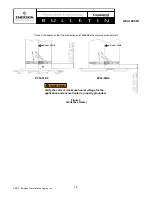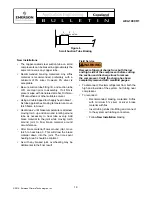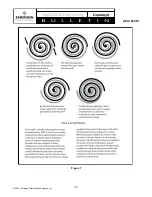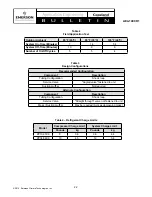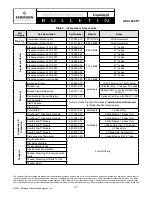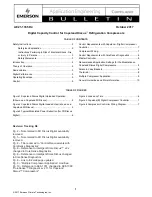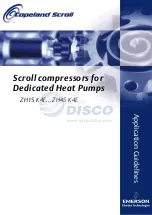
14
© 2015 Emerson Climate Technologies, Inc.
AE4-1400 R1
3. Check that the compressor is correctly wired.
4. Proper indoor and outdoor blower/fan operation
should be verified.
5. With service gauges connected to suction
and discharge pressure fittings, turn on the
compressor. If suction pressure falls below normal
levels the system is either low on charge or there
is a flow blockage in the system.
6. Single phase compressors
– If the compressor
starts and the suction pressure does not drop
and discharge pressure does not rise to normal
levels, either the reversing valve (if so equipped)
or the compressor is faulty. Use normal diagnostic
procedures to check operation of the reversing
valve.
Three phase compressors
– If suction
pressure does not drop and discharge pressure
does not rise to normal levels, reverse any two of
the compressor power leads and reapply power
to make sure the compressor was not wired to
run in reverse. If pressures still do no move to
normal values, either the reversing valve (if so
equipped) or the compressor is faulty. Reconnect
the compressor leads as originally configured
and use normal diagnostic procedures to check
operation of the reversing valve.
7. To test if the compressor is pumping properly,
the compressor current draw must be compared
to published compressor performance curves
using the operating pressures and voltage of
the system. If the measured average current
deviates more than +/-20% from published values,
a faulty compressor may be indicated. A current
imbalance exceeding 20% of the average on the
three phases of a three-phase compressor should
be investigated further. A more comprehensive
trouble-shooting sequence for compressors and
systems can be found in Section H of the
Emerson
Climate Technologies Electrical Handbook,
Form No. 6400.
8. Note that the ZP10-31K6 three-phase motors
use a modified "Scott-T" connection and don't
have equal resistances on all three windings.
Two windings will have equal resistances and the
third winding will be up to 30% different from the
other two. Carefully compare measured motor
resistance values to the two different published
resistance values for a given compressor model
before replacing the compressor as being
defective. The larger ZP34-54K6 compressors
have conventional three-phase motors with equal
resistances in each winding.
9. Before replacing or returning a compressor, be
certain that the compressor is actually faulty. As
a minimum, recheck compressors returned from
the field in the shop or depot by testing for a
grounded, open or shorted winding and the ability
to start. The orange tag in the service compressor
box should be filled out and attached to the failed
compressor to be returned. The information on this
tag is captured in our warranty data base.
Compressor Replacement After a Motor Burn
In the case of a motor burn, the majority of contaminated
oil will be removed with the compressor. The rest of the
oil is cleaned with the use of suction and liquid line filter
driers. A 100% activated alumina suction filter drier is
recommended but must be removed after 72 hours. See
AE24-1105
for clean up procedures and
AE11-1297
for
liquid line filter-drier recommendations.
NOTICE
It is
highly recommended that the suction accumulator
be replaced if the system contains one.
This is
because the accumulator oil return orifice or screen may
be plugged with debris or may become plugged shortly
after a compressor failure. This will result in starvation of
oil to the replacement compressor and a second failure.
The system contactor should be inspected for pitted/
burnt contacts and replaced if necessary. It is highly
recommended that the run capacitor be replaced when
a single phase compressor is replaced.
Start-Up of a New or Replacement Compressor
It is good service practice, when charging a system
with a scroll compressor, to charge liquid refrigerant
into the high side only. It is not good practice to dump
liquid refrigerant from a refrigerant cylinder into the
crankcase of a stationary compressor. If additional
charge is required, charge liquid into the low side of
the system with the compressor operating.
CAUTION
Do not start the compressor while the system is in
a deep vacuum.
Internal arcing may occur when any
type of compressor is started in a vacuum.
NOTICE Do
not operate the compressor without enough system
charge to maintain at least 55 psig (3.8 bar) suction
pressure. Do not operate with a restricted suction
or liquid line. Do not operate with the low pressure
cut-out disabled.
Allowing suction pressure to drop
below 55 psig (3.8 bar) for more than a few seconds
may overheat the scrolls and cause early drive bearing
damage. Never install a system in the field and leave


















